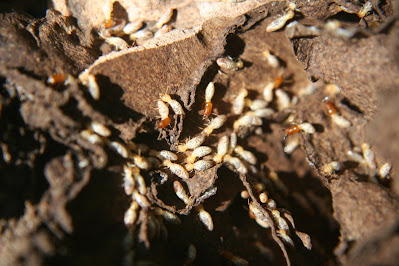Antibiotics from Insects
Dr Abe V Rotor
 Poultice made from soldier termites is effective cure of wounds and sores.
Poultice made from soldier termites is effective cure of wounds and sores.The declining effectiveness of commercial antibiotics as a result of increasing resistance of pathogens makes it necessary to search for more potent ones from various sources - plants, animals, fungi and unicellular organisms. A proposed study is focused on insects with the following premises.
• The use of insects and their products in alternative medicine dates back to olden times with the use of wild honey as poultice for wounds and infections other than its principal use as health food. Even today the practice of alternative medicine in clinics and among doctors in the U.S. and other parts of the world include the popular use of bee venom in the treatment of arthritis and rheumatism.
• A mealy bug, (Dactylopius coccus) produces cochineal. The insect is reportedly being cultured commercially in Honduras, Canary Island, Mexico, Peru and Spain. Cochineal is extensively used as dye but lately it has been discovered to possess properties that allay pain, and its effectiveness in treating whooping cough and neuralgia.
• One potential source of antibiotics is the green tree ant (Oecophylla smaragdina), a member of the large order of insects, Hymenoptera, to which bees and wasps belong. Like their relatives, the green tree ant, locally known as hantik, lives in colonies. This social behavior enables them to grow in numbers of hundreds or thousands in a single colony, which can remain active for a long time. Other than its reported antibiotic property, the papery secretion attached to the leaf nest and the crushed bodies of the larva and the adult green tree ant relieve inflammation when applied on the affected area. the green ant of the Family Formicidae, is used to prepare a refreshing drink, curing headaches, and as cold remedy, and as an antiseptic and expectorant
• In the case of the leaf-cutter ants (Myrnica sp), success in growing fungus that serves as their food, depends largely in producing enzymes that have antibiotic properties, thus reducing competition with other microorganisms. The ants also remove and destroy directly alien microorganisms from their garden.
• Australian aborigines extensively use insects from their surroundings as food, medicine. The larvae of the witchery grub (Xyleutes leucamocha Turn) are rich in calories, protein and fat. The natives also crush grub to provide covering for wounds and burns.
• The honey pot ant (Melophorus batgoti Lubbock) provides sugar believed to be an elixir. The honey bag of the sting less native bee (Trinomial sp) which is directly consumed by natives as food, is also used for medicine in “cleaning their guts out”, meaning as purgative. The importance of insects to these natives extends to aboriginal fables, art, sorcery and folk healing.
• A substance from the secretion of the maggots has the same property of healing infected wounds as the maggot themselves. This material known as allantoin is described as harmless, odorless, stainless, painless, and inexpensive lotion which when applied to chronic ulcers, burns and similar pus-forming wounds, stimulates local granulation. It is also of special value in treating deep wounds such as bone marrow infections where the internal part of the wound must be healed first.
• During the First World War, Dr. W. S. Baer noticed that wounds of soldiers who had been lying on the battlefield for hours did not develop infections, such as osteomyelitis, as did those that had been treated and dressed promptly after they were inflicted. The difference was due to the fact that the older wounds were infested with maggots developed from eggs laid about the wounds by certain flies. The remarkable recovery that these maggots could clean up the infection in deep-seated wounds much better than any known surgical or medicinal treatment led to the practice of rearing maggots of the housefly (Musca domestica) and certain blue bottle flies (Caliphora vomitaria) under sterile conditions. These surgically clean maggots are then introduced into the wounds to eat up particles of putrefied flesh and bone resulting to early healing.
• Another insect with medicinal value is the blister beetle, so-called “Spanish fly” (Lytta vesicatoria) that occurs in abundance in France and Spain, and a relative of the American blister beetle. The beetle carries in its body cantharidin. It is used as folk medicine during the 19th century for all sorts of ailments, and was used as aphrodisiac. At present it is used in treating certain diseases of the urinogenital system and in aiding animal breeding. However, the use of insects as medicinal remedy may be pure quackery or based on superstitious belief.
In the seventeenth century people attributed curative power to certain insects. For example, the bite of katydid or cricket will remove warts. Cockroaches or earwig when dried and compounded will cure ulcer, weak sight, earache and dropsy. But there are authentic reports that border superstition and truth. For example, spiders are thought to heal wounds because of their web-forming habits that are likened to the stitching of wounds. Indeed by applying a mass of spider web on wound hastens its healing, an ethnic practice known in many rural communities.
References: Useful and Destructive Insects, by Metcalf and Flint; The Social Biology of Ants, by Dumpert; Living with Nature, AVRotor ~


No comments:
Post a Comment